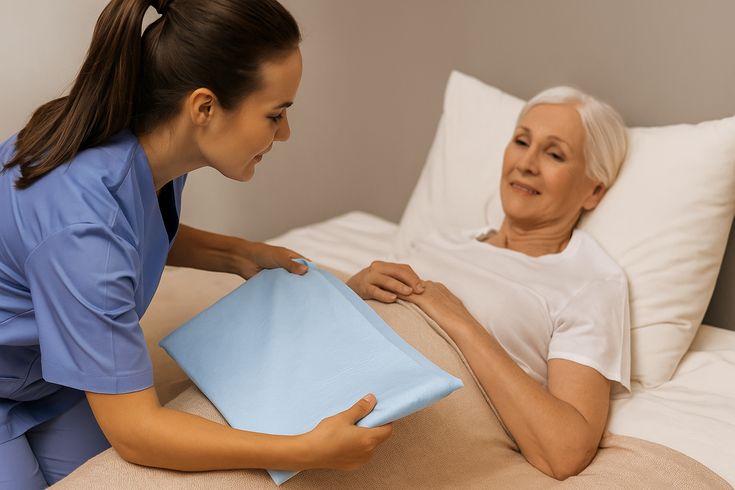In clinical nursing, pressure injury and incontinence-associated dermatitis are two common skin problems, but their causes, manifestations, and treatments are fundamentally different. Let's take a look at how to differentiate them.

What are the differences in their pathogenesis?
Pressure injuries are primarily caused by sustained pressure, shear force, or friction, leading to local tissue ischemia and hypoxia. These injuries typically occur at bony prominences and are related to the tissue's pressure tolerance. Incontinence-associated dermatitis, on the other hand, is caused by prolonged contact of urine or feces with the skin; chemical irritation and a moist environment combine to cause skin inflammation. The former is a mechanical injury, while the latter is a chemical injury.
How to differentiate the manifestations of skin lesions?
Pressure injuries result in well-defined lesions that typically correspond to the site of pressure. Initially, they present as persistent erythema that does not change color upon pressure. In severe cases, blisters, ulcers, and even penetrating to the bone may develop. The lesions are usually round or oval in shape and located in a fixed position.
Incontinence-associated dermatitis (IAD) presents with extensive skin lesions and indistinct borders. The skin appears bright red, accompanied by edema and a warm sensation. Papules and erosions may occur, but deep ulcers are rare. Lesions are distributed in areas that come into contact with excrement, such as the perineum, buttocks, and inner thighs.
What are the differences in symptom presentation?
Patients with pressure injuries often complain of localized pain and numbness, with the intensity of pain correlated with the depth of the injury. Palpation may reveal changes in skin temperature; it may be elevated in the early stages and decreased in later stages. The texture of the tissue may harden or soften, depending on the stage of the injury.
Incontinence-associated dermatitis primarily manifests as burning, itching, and stinging. Frequent scratching due to discomfort can lead to secondary infections. The skin surface remains moist and may appear macerated and whitish.
What factors need to be assessed ?
Risk factors for pressure injuries include limited mobility, sensory disturbances, and malnutrition. The Braden scale is used for assessment; lower scores indicate higher risk. Attention should be paid to the patient's ability to change position, skin condition, and nutritional status.
Risk assessment for incontinence-associated dermatitis focuses on the type and frequency of incontinence. The risk is highest when both loose stools and urinary incontinence are present. It is necessary to assess the duration of skin exposure, cleaning methods, and use of protective equipment.
What are the differences in the focus of preventive measures ?
The key to preventing pressure injuries is reducing localized pressure. Establish a repositioning schedule, changing positions every two hours. Use pressure-relieving mats and special mattresses to distribute pressure. Keep skin clean and dry, and avoid friction and shearing forces.
The key to preventing incontinence-associated dermatitis is isolating the body from irritants. Use skin protectants to create a barrier. Change soiled clothing and sheets promptly. Choose highly absorbent care products. Establish a regular bowel and urination schedule.
What are the differences in the handling principles?
The core of managing pressure injuries is relieving pressure. Appropriate dressings are selected based on the stage: thin-film dressings for stage I, hydrocolloid dressings for stage II, and debridement and specialized dressings for stage III and beyond. Nutritional support is also crucial to promote tissue repair.
The key to managing incontinence-associated dermatitis is isolation and moisturizing. Use a diaper rash cream containing zinc oil to protect the skin. Choose gentle cleansing products and avoid excessive rubbing. Use a barrier cream to repair the skin's protective layer. Control incontinence and reduce the time of contact with irritants.

Do complications develop along different pathways?
Pressure injuries can progress to deep tissue damage, secondary infection, and even sepsis. The healing process is slow, and chronic wounds are prone to develop. The risk of recurrence is high, requiring long-term monitoring.
Incontinence-associated dermatitis can be secondary to fungal or bacterial infections. Long-term, recurrent flare-ups can lead to thickened skin and hyperpigmentation. It can negatively impact a patient's quality of life and cause psychological distress.
For more information on Innomed®Hydrocolloid Dressing, Refer to the Previous Articles. If you have customized needs, you are welcome to contact us; You Wholeheartedly. At longterm medical, we transform this data by Innovating and Developing Products that Make Life easier for those who need loving care.
Editor: kiki Jia

 English
English عربى
عربى Español
Español русский
русский 中文简体
中文简体








